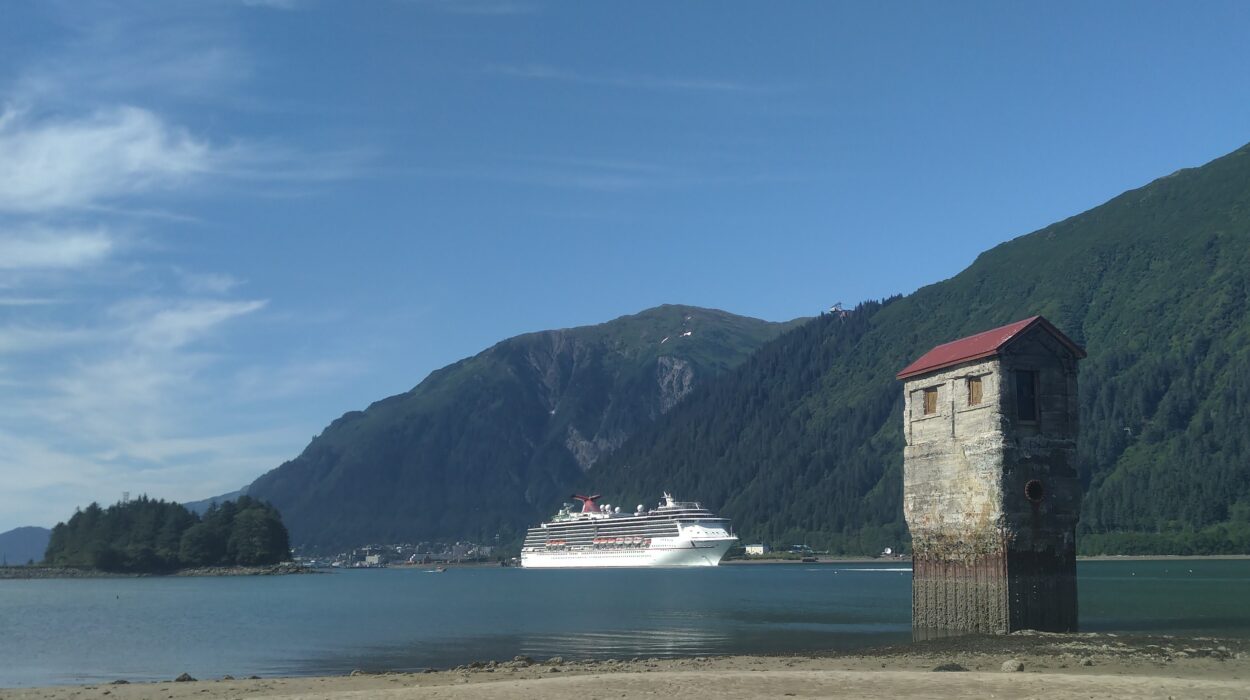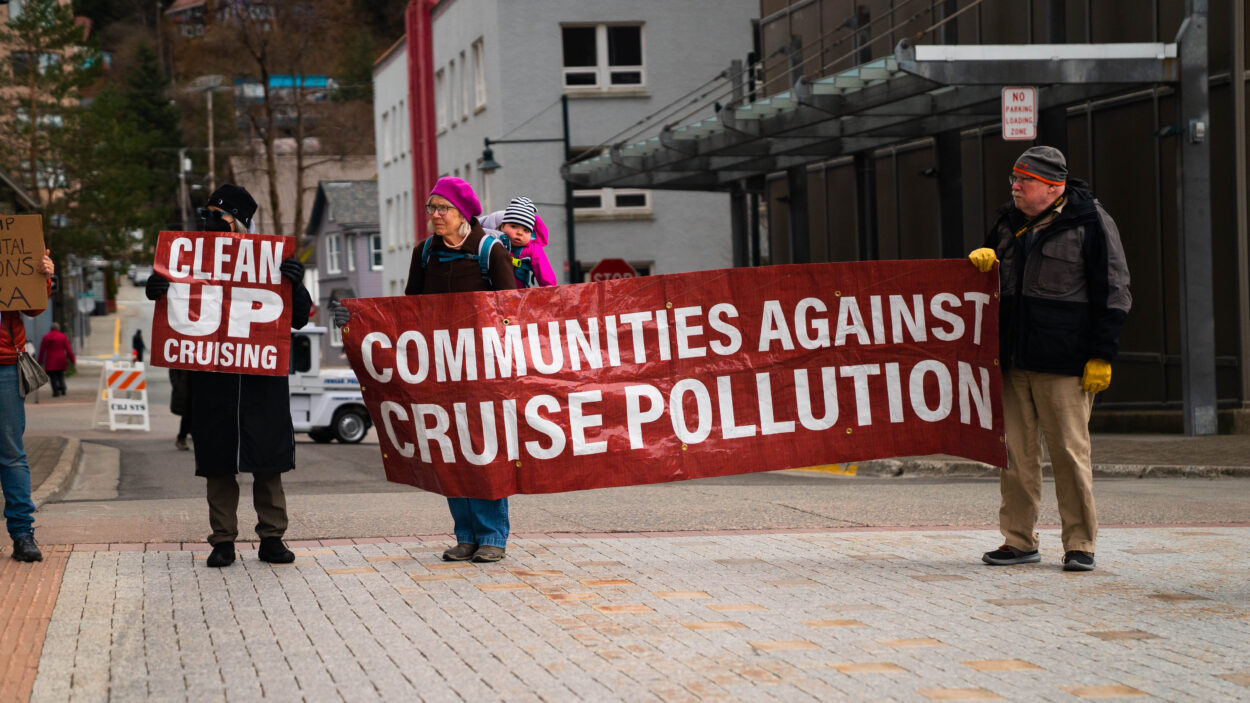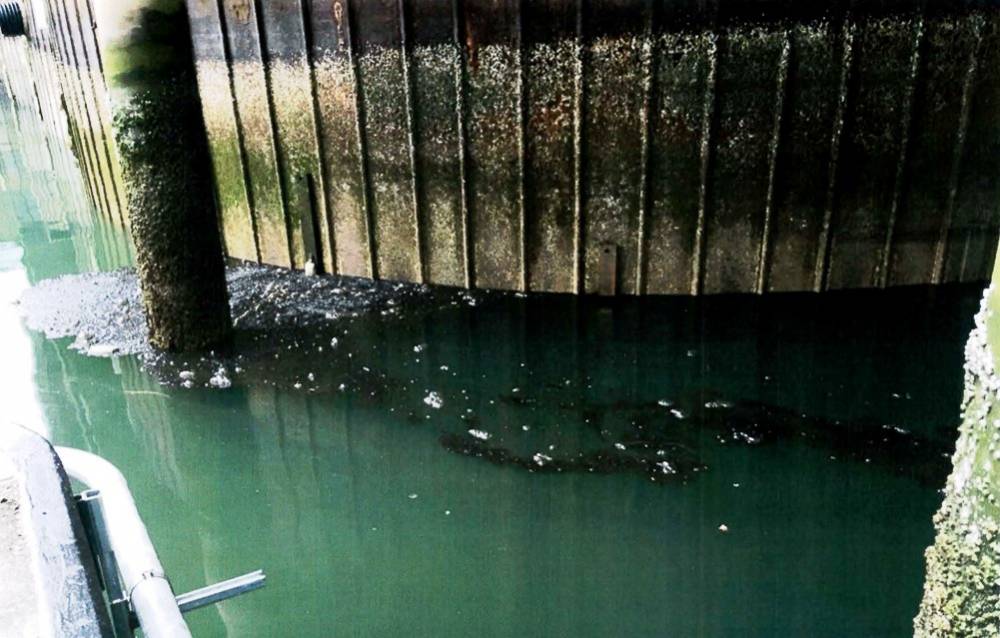
The Carnival Spirit departs Juneau on July 31, 2021. The ship is equipped with Exhaust Gas Cleaning Systems allowing it to burn cheaper, dirtier fuels in Alaska waters. (Photo by Jacob Resneck/CoastAlaska)
Audio Player
Cruise ships are now returning to Alaska for the first full-length season since the pandemic. It’s a relief for coastal port economies whose visitor sector has struggled.
But more ships also means more pollution, either to the air, the water or both from these large ships even as the industry says it’s committed to net zero emissions by 2050.
For the past several years there’s been a debate between regulators over what to do about “scrubbers”: a controversial anti-air pollution device that dissolves chemicals from ships’ exhaust into seawater, allowing the shipping industry to burn cheaper, dirtier fuels.
A two-year CoastAlaska investigation uncovered dozens of reports from independent cruise ship monitors alerting state authorities to foamy discharges from the kind of scrubber systems used by ships owned by Carnival Corp. and its subsidiaries, which make up a large portion of the Alaska cruise ship fleet.
State and federal authorities didn’t take steps to curb the emissions. State environmental regulators in Alaska say they don’t regulate scrubber discharges, and a federal law meant to protect the owners of small fishing boats from massive fines has, in practice, prevented state officials on much of the West Coast from clamping down on water pollution from scrubbers aboard cruise ships. Critics say it’s a weakness in environmental regulations that for years has allowed the cruise industry to pollute Alaska’s waters.
‘Air pollution to water pollution’
Technically called Exhaust Gas Cleaning Systems, they’re more commonly known as scrubbers. That’s because they use seawater to “scrub” the sulfur from the engines’ exhaust. They’re required by the International Maritime Organization which has mandated lower sulfur emissions in the atmosphere, which regulators say is harmful to human health, and is a major driver of acid rain. They’re prized by the industry as a way to save money and allow ships to burn the cheapest, dirtiest fuels. But the toxic chemicals removed from smokestack exhaust don’t just disappear.
A video shot from the deck of the Holland America Line cruise ship Amsterdam in the summer of 2019 captured a churning and bubbling of water spewing from the ship’s starboard side. By 7 a.m. — about 1 minute 22 seconds into the video — what appears to be a sea lion swims through the oily water.
Former Ocean Ranger Robert Layko was on a different ship that day. But he says he saw these kinds of oily discharges all the time.
“If they were running their open-loop scrubbers in port, you could see a sheen – black, like soot – on the side of the ship where their discharge was coming out,” Layko said.
The Ocean Rangers were an independent monitoring program unique to Alaska. And for years they tracked all manner of pollution and reported them to the ship’s deck officers and state regulators.
The Ocean Ranger that summer morning in Hoonah logged a report with state regulators. It sat in a file until turned over in a records request to CoastAlaska that included the June 22, 2019 video which said the sheen was likely generated by the Amsterdam’s scrubbers.
Carnival Corp. and its subsidiaries like Holland America first installed these systems in 2014. Dark billowing smoke from the ship’s stacks led to widespread complaints but little action by state regulators.
“We’re supposed to report any pollution incident we see,” Layko said, who spent eight seasons as an Ocean Ranger. “When I was on the ships, I would tell them that I’m going to report those because it’s my job and it’s pollution to me, and they say their scrubbers are all in compliance.”
Some scrubbers run a closed-loop system. Its washwater is heavily filtered, leaving a thick sludge that’s sent to landfills in the Lower 48.
But in the open-loop systems used by Carnival, Holland America and Princess ships, there’s no sludge to be hauled away at the end of a voyage. The seawater used to dissolve sulfur, arsenic and other potentially harmful contaminants goes right back overboard.
Shipping industry critics say scrubbers have allowed the shipping industry to skirt regulations by exchanging one form of pollution for another.
“What would normally be emitted as air pollution and dispersed in the atmosphere is now being concentrated and dumped directly overboard,” said Bryan Comer, a maritime expert with the International Council on Clean Transportation in Washington D.C. who has written about open loop scrubbers.
Congress preempts states from scrubber regulation
Layko reported the oily sheens he saw to the Alaska Department of Environmental Conservation. But there’s little states can do to control discharges from exhaust scrubbers.
That’s because states like Alaska lost much of their authority to regulate scrubber discharge through an act of Congress. Alaska’s delegation were champions of legislation called the Vessel Incidental Discharge Act.
Sen. Lisa Murkowski (R-Alaska) says it was over concerns for the commercial and charter fishing fleet.
“What we really set out to do with VIDA was to address the incidental discharge off of fishing vessels,” Murkowksi told CoastAlaska in 2019.
She says her office got involved to protect the skippers of fishing boats from fines under the Clean Water Act. When deckhands spray down their boats, sometimes the water that washes overboard includes some oily residue.

A small group of environmental demonstrators gather near the Capitol in downtown Juneau on April 26, 2022 to protest pollution from large cruise ships. (Photo by Paige Sparks/KTOO)
But some state regulators say the 2018 law’s definition of “incidental” goes far beyond small fishing boats and cripples the ability of state water quality monitors to regulate ships the size of office buildings that discharge hundreds of thousands of gallons of scrubber washwater every hour.
Washington State Department of Ecology’s Amy Jankowiak, a supervisor in its water quality section, told CoastAlaska there’s specific language in the law, “that preempts states from regulating quite a few of the different types of discharge types coming off of vessels.”
But the law’s passage was just the first step in a complex process. The EPA now has to write the regulations that say exactly how and when scrubbers can discharge in U.S. waters, which fall to the U.S. Coast Guard to enforce. But today, four years after the law was passed, it has yet to do so as the regulations remain to be finalized.
Jankowiak says Washington’s Ecology Department has done its own research into scrubber discharges. Not only were they acidic — which can harm sea life — state scientists found a host of contaminants.
“Polycyclic aromatic hydrocarbons, or PAHs, were significantly high,” she said, “and toxics including some metals, arsenic, cadmium, copper, nickels, selenium, zinc – all were higher than our water quality criteria.”
Washington state is calling on the EPA to ban scrubbers while more research is done. California has banned heavy fuel oils near its coastlines since 2008, making scrubbers unnecessary.
“We believe that there are enough concerns for the water for water quality, not just in our waters, but in other states’ waters,” Jankowiak said.
Alaska state regulators mum on scrubbers
Alaska state regulators have attended listening sessions on the debate over scrubbers in U.S. waters, EPA records show. But DEC officials have declined to wade into the debate themselves. The state of Alaska’s cruise ship program has a public-facing website that explains the technical aspects and notes that it’s up to the EPA to regulate scrubbers.
“The department has not taken any regulatory action regarding scrubbers,” DEC spokeswoman Laura Achee wrote in an email.
But DEC has a lot of data in its files. Ocean Rangers routinely monitored scrubbers and their performance and passed them on to cruise ship program staffers. Between 2017 and 2019, the marine engineers collectively logged at least 80 oily sheens and referred them to state’s Spill Prevention and Response Division for potential enforcement.
SPAR officials say they logged 24 scrubber discharge reports in 2017, 38 reports in 2018 and 18 reports in 2019. No further action was taken, staffers at the agency confirmed.
DEC is supposed to forward reports of scrubber water pollution to the U.S. Coast Guard.
A records request by CoastAlaska found that of the 18 documented observations by Ocean Rangers in 2019 only one was forwarded to the Coast Guard for potential action. But again, there’s no record of enforcement by either agency.
The pandemic erased the 2020 cruise season. And in 2021, Ocean Rangers were removed from cruise ships after Gov. Mike Dunleavy shut down the program. (He vetoed the money from cruise ship passengers that funded it.)
The Dunleavy administration has been hostile to the program, saying no other industry has that kind of 24/7 scrutiny.
“Most of these Ocean Rangers were not even Alaskans,” DEC Commissioner Jason Brune said during an appearance on a state-sponsored podcast last November. “They were retired marine engineers from the Lower 48 that were getting a free vacation on these cruise ships.”
He reiterated that the Dunleavy administration wants agency staff to inspect vessels and permanently end the program that was created by a 2006 voter initiative and remains popular among coastal communities.
The Legislature is still hearing the governor’s bills that would formally end the program.
Scrubber manufacturers tout systems’ potential
The shipping industry insists scrubbers are both safe and effective. Donald Gregory heads the Exhaust Gas Cleaning Systems Association in the U.K. which represents global manufacturers. He predicts one day that all large ships will be outfitted with the technology.
“But it won’t be fitted to remove the sulfur dioxide, necessarily,” Gregory said. “It’ll be fitted to take out black carbon, and to take out some of these other compounds. And that’s where the real benefits will be.”
That would also allow the shipping industry to delay switching to cleaner, more expensive alternatives to fossil fuels.
Gregory also dismisses concerns about water pollution.
“What’s going overboard is going overboard anyway — through the funnel — if it’s not being scrubbed,” he said in an interview from Greater London.
But without the scrubbers, ships wouldn’t be allowed to burn the dirtier fuels in the first place.
Cruise industry says scrubbers are ‘interim solution’
CoastAlaska repeatedly requested interviews from Cruise Lines International Association. The industry group declined.
But the topic does come up when cruise execs attend public forums. During an appearance last summer on Wrangell public radio station KSTK’s Talk on the Rock, CLIA executive Brian Salerno says scrubbers perform well.
“They do meet all the international standards,” he told KSTK interviewer Sage Smiley. “They meet the EPA standards for the U.S., there have been quite a few tests on them, particularly with the washwater.”
CLIA touted last year the fact that 76% of the large cruise ship fleet is equipped with scrubbers.
“I realize not everybody is prepared to look at them in the same way,” Salerno said. “But as an interim solution for now, they’re doing the job. I think long term, though, you know, we need new solutions.”
Scrubbers save Carnival ships in Alaska $150,000 a week

Discharge from the Star Princess was seen by City of Ketchikan port personnel on July 23, 2018 at Berth 4. That follows complaints by the public of an earlier discharge from the Golden Princess. The city has determined the discharge is from exhaust system scrubbers. (City of Ketchikan photo)
In court filings, Carnival Corporation says its brands have spent at least $500 million on installing scrubbers on its fleet. So why the huge investment? It says it’s to cut costs in the long-run by allowing them to burn the dirtiest fuels close to shore.
“The exemption gives us the flexibility to use whatever fuel source we determine. And that’s significant for us because it gives an economic value,” Carnival spokesman Roger Frizzell told CoastAlaska in 2013 when the scrubbers were first being installed ahead of more stringent sulfur limits in marine fuel.
Carnival reported to the EPA that switching its vessels in Alaska to cleaner-burning marine gas oil would be too expensive.
At 2019 prices, it says burning lower-sulfur fuels would increase a ship’s fuel bill by an extra $150,000 a week.
Jim Gamble, the Arctic program director for conservation group Pacific Environment, is pushing for a ban on heavy fuel oil in Alaska waters and by extension, scrubbers that allow bunker oil on board ships in U.S. waters.
His organization is part of the Clean Up Carnival campaign — a coalition of environmental groups urging the Miami-based cruise giant to stop burning heavy fuel oil on its ships.
“A company like Carnival can easily afford to come into Alaskan waters and follow every regulation,” Gamble said.
He says the environmental cost is higher than the money Carnival saves by running scrubbers to burn cheaper fuels.
EPA allows Carnival ships in Alaska to discharge scrubber water that’s two, three times as acidic
Carnival has received special permission for its open loop scrubbers to exceed water pollution rules while in Alaska waters. That’s according to waivers obtained through a Freedom of Information request filed by CoastAlaska. The EPA has green-lit discharging scrubber washwater with a pH more acidic than what’s allowed under its 2013 permits.
“The pH scale is logarithmic,” explained Bryan Comer of the ICCT Marine Program, in an email. “That means that allowing Carnival to emit washwater with a pH of 5.7 instead of 6.0 is really allowing them to emit water that is twice as acidic. And on the occasions where they emit contaminated washwater with a pH of 5.5, that’s 3.2-times more acidic than if it had a pH of 6.0.”
Scrubber discharges aren’t always obvious but critics say the volumes are significant. Some estimates by Washington state say they churn out around 475,000 gallons every hour.
Cruise ships may avoid extra scrutiny by not running them in port where the sheens are more visible. And since last year, there have been no Ocean Rangers on board to watch and record them.
Robert Layko, the retired Ocean Ranger, says he’s worried scrubber water pollution will now go unreported.
“If we’re not watching them, it’s up to the public to watch them and the public — they’re not engineers,” Layko said. “It seems to me like the state kind of dropped the ball a little bit.”
DEC confirmed that in 2021 it received three public complaints about cruise ships, two for air quality and one for water. The agency says none of the complaints resulted in action.
A Carnival spokesperson confirmed that its fleet would continue to operate under its waivers for the 2022 cruise season. The EPA declined to comment on progress of its exhaust gas cleaning system regulations which are expected to be finalized at the end of the year.
In Alaska, the public can report suspected cruise ship pollution to the state Department of Environmental Conservation’s cruise ship program by emailing: DEC.WQ.Cruise@alaska.gov





